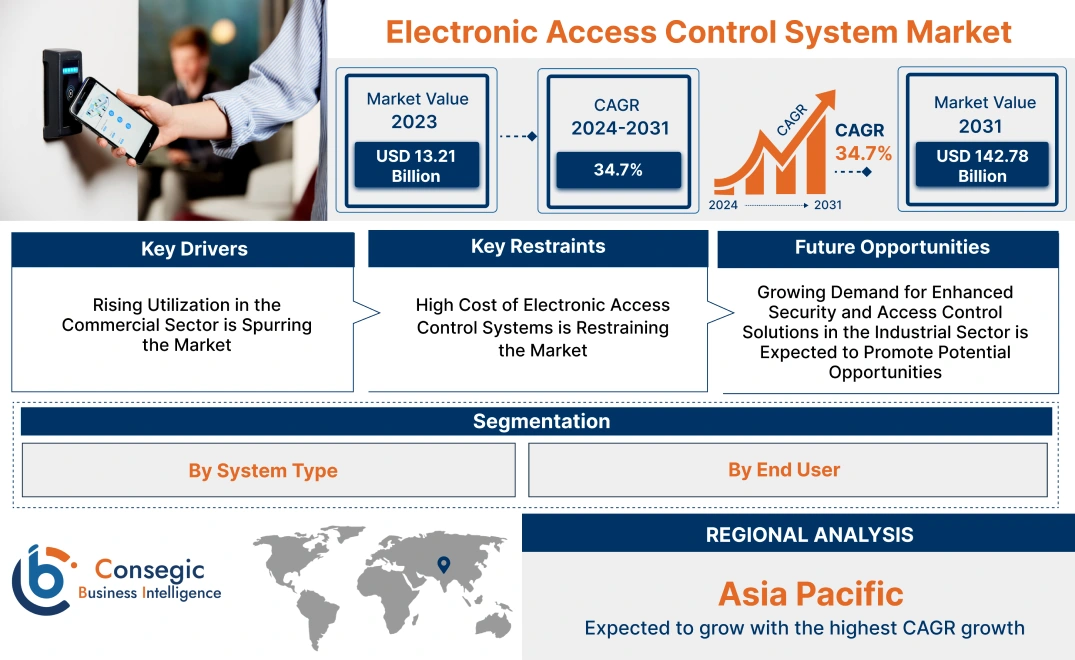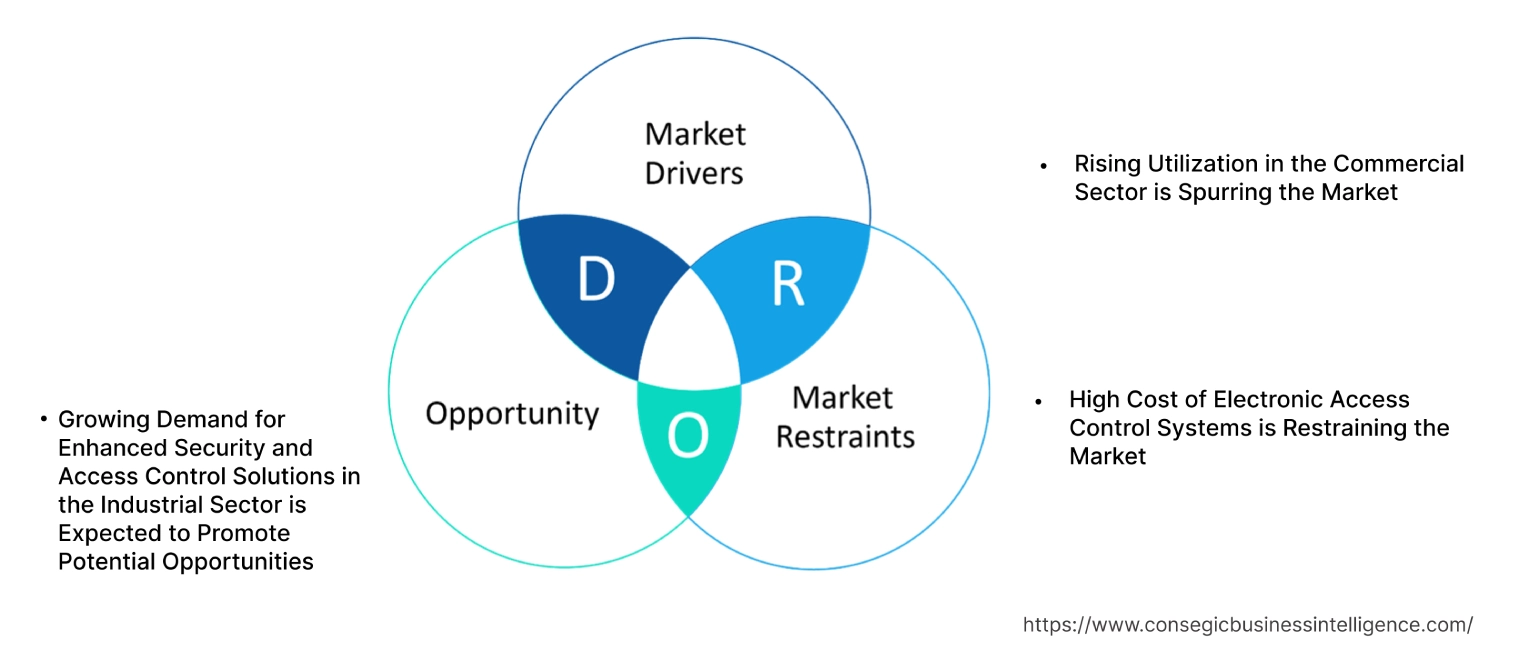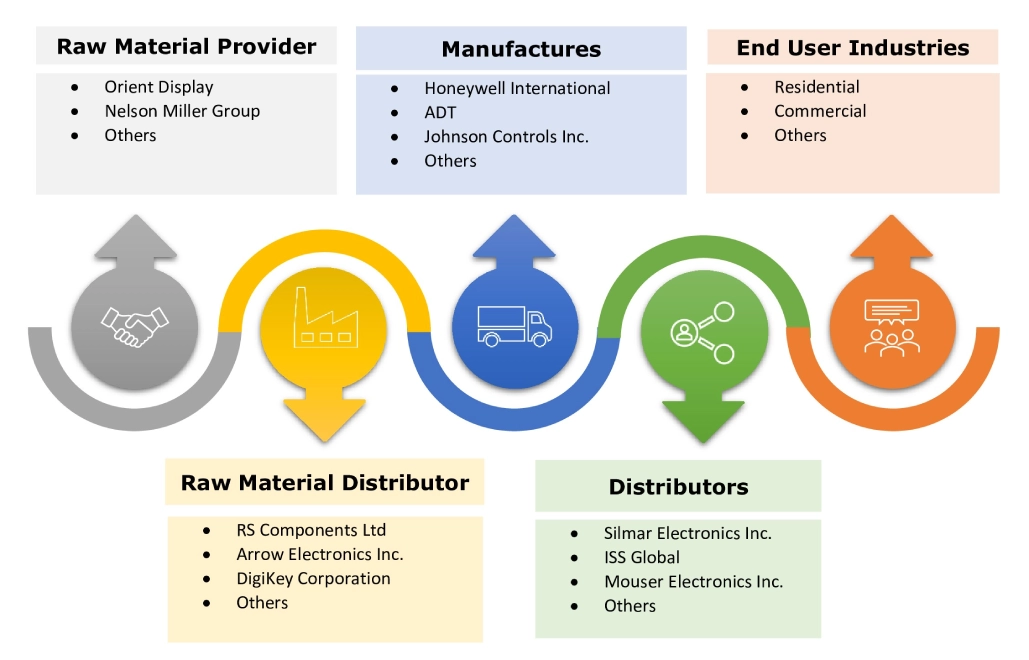- Summary
- Table Of Content
- Methodology
Electronic Access Control System Market Size:
Electronic Access Control System Market size is estimated to reach over USD 28,940.45 Million by 2031 from a value of USD 14,785.44 Million in 2023 and is projected to grow by USD 15,816.87 Million in 2024, growing at a CAGR of 8.8% from 2024 to 2031.
Electronic Access Control System Market Scope & Overview:
An electronic access control system refers to a system that is mainly designed to provide or deny access to a particular space. These systems ensure the entry of only authenticated and authorized personnel into a specific space or to acquire a specific resource. They work by utilizing a combination of credentials, credential readers, and computer systems to deliver a higher and more reliable level of safety and security. They also provide a high degree of accountability to their users and administrators. The aforementioned characteristics of these systems are key determinants for increasing their adoption in residential, commercial, and industrial sectors.
Electronic Access Control System Market Insights:
Key Drivers:
Rising Utilization in the Commercial Sector is Spurring the Market
Electronic access control systems such as biometric systems, card-based access control systems, and others are deployed in the commercial sector including offices, hotels, resorts, hospitals, and educational institutes among others for enhanced security. The deployment of these systems in commercial buildings enables the property staff to manage individuals' access to a building or certain areas of a property. Moreover, these systems aid in improving property security and convenience across offices, businesses, and other commercial properties while providing entry to only authorized users within the commercial property.
- For instance, according to Statistics Netherlands, the total number of new construction of commercial buildings across the nation including healthcare facilities, offices, educational institutions, retail shops, and others reached up to 1,042 units in 2022.
Hence, the rising development of commercial spaces is increasing the utilization of these systems in commercial buildings to offer improved security, in turn driving the electronic access control system market trends.
Growing Residential Construction is Driving Market Growth
Electronic access control systems are often installed in residential buildings to authenticate individuals and give access to entry to the building only to authorized individuals. Moreover, the installation of these systems in residential buildings provides several benefits such as enhanced security, ease of customization, reduced risk of theft and robbery, and the ability to control multiple doors remotely, which are primary aspects for driving its application in residential buildings. Additionally, the increasing incidence of theft and robbery along with the rising need for enhanced security in residential buildings are among the key factors driving the application of these control systems in residential buildings.
- For instance, according to BC Housing, approximately 51,407 registered new homes were recorded in the British Columbia province of Canada in 2022, among which 42,370 were multi-unit buildings and 9,037 were single detached homes. Similarly, the number of multi-unit homes British Columbia province of Canada reached 42,370 units in 2022, representing a growth of 3.6% in comparison to 2021.
Thus, the growing residential construction is driving the adoption of these systems in residential spaces for providing enhanced occupant security, thereby, proliferating the electronic access control system market growth.
Key Restraints :
High Cost of Electronic Access Control Systems is Restraining the Market
The implementation of these systems is usually associated with high costs. The high costs are due to the need for multiple components for its installation such as biometric scanners, electronic locking hardware, a network connection, and computer hardware and software, which is relatively very high in comparison to the cost of conventional mechanical locks for access control.
Therefore, the analysis of market trends depicts that the high cost associated with the implementation of these systems is restraining the electronic access control system market demand.
Future Opportunities :
Growing Demand for Enhanced Security and Access Control Solutions in the Industrial Sector is Expected to Promote Potential Opportunities
Industrial buildings such as warehouses, logistics centers, distribution facilities, and others store large quantities of expensive goods that are often targeted by intruders and robbers. Hence, electronic access control systems such as intruder detection systems, perimeter security systems, and biometric systems among others are often installed in industrial buildings to offer advanced security of high-value products and prevent access of intruders within the premises.
Consequently, the rising development of industrial buildings will increase the adoption of these systems such as intruder detection systems, perimeter security systems, and others to control the access of unauthorized intruders within industrial premises. Thus, the analysis of market trends shows that the aforementioned reasons are boosting the electronic access control system market opportunities.
Electronic Access Control System Market Segmental Analysis :
By System Type:
Based on the system type, the market is trifurcated into authentication systems, intruder alarm systems, and perimeter security systems.
Trends in the System Type:
- Increasing technological advancements associated with biometric access control systems involving fingerprint recognition, face recognition, iris recognition, and others.
- There is an increasing adoption of card-based access control systems in offices, hotels, resorts, and other commercial spaces.
The authentication system segment accounted for the largest revenue share in 2023 of the overall electronic access control system market share.
- Authentication systems identify users who request access to a system, network, or device. An authentication access control system determines a user's identity through acquisitions of credentials including usernames, passwords, biometrics, and others to manage a user's access to a particular system or space.
- Authentication access control systems offer various benefits including ease of implementation, higher level of security, and accurate consumer identification among others.
- Authentication systems such as biometric access control systems and card-based access control systems are often deployed in residential buildings and commercial buildings for authentication and authorization of individuals' access to the buildings or specific spaces.
- In August 2022, Aratek, a Taiwan-based security company, launched its new multi-mode biometric system for effective access management applications. The biometric system is integrated with finger and face recognition capabilities along with RFID card support. The biometric system is specifically designed for access control as well as attendance management in the commercial sector. The system also enables administrators to set access levels by respective work schedules and helps in the configuration of integrated physical access control systems remotely.
- Thus, analysis of segmental trends shows that the rising innovation associated with authentication systems such as biometric access control systems is driving the electronic access control system market growth.
The intruder alarm system segment is anticipated to register a significant CAGR during the forecast period.
- An intrusion alarm system is capable of monitoring and detecting unauthorized access to a building.
- The main objective of an intrusion alarm system is to protect a property from vandalism, burglary, and property damage, and to improve the security of the individuals within the building.
- The implementation of intrusion alarm systems offers several benefits including faster intruder alert, safer working environment, and reduced risk of theft and robbery.
- Moreover, intrusion alarm systems offer higher flexibility and can be integrated for access control in residential, commercial, and industrial buildings.
- In May 2022, Hikvision launched its new alarm system, AX Hybrid PRO. The alarm system is integrated with Hikvision Speed-X transmission technology. It is designed for deployment in banks, offices, factories, and retail stores among others.
- Therefore, the increasing advancement associated with intrusion alarm systems is anticipated to boost the electronic access control system market opportunities during the forecast period.
By End-User:
Based on the end user, the market is trifurcated into residential, commercial, and industrial.
Trends in the End-User:
- The commercial sector has seen a significant increase in the utilization of electronic access control systems for providing improved access control and enhanced security of commercial spaces.
The commercial sector accounted for the largest revenue share of 45.29% of the electronic access control system market share in 2023.
- This dominance is attributed to the rising adoption of electronic access control systems such as biometric systems, card-based electronic access control systems, and others in commercial spaces including offices, hotels, resorts, hospitals, and educational institutes among others.
- Additionally, the increasing development of commercial buildings has further propelled the market expansion.
- According to Statistics Canada, the total commercial construction permits in Canada were valued at USD 1,544,997 in December 2022, witnessing an increase of 6.4% in comparison to USD 1,451,624 in December 2021.
- Thus, the growing commercial sector is driving the electronic access control system market trends.
The residential sector is anticipated to register a significant CAGR during the forecast period.
- Factors including the rise in disposable income, increasing investments in residential construction, and government policies including tax incentives, subsidies, and rebates are key prospects for driving the progress of the residential sector.
- According to the United States Census Bureau, the total number of new residential units sold in the United States reached up to 184 thousand units during the second quarter of 2023, witnessing a growth of 14.2% in comparison to 161 thousand units in the second quarter of 2022.
- Therefore, the growing residential construction is anticipated to boost the electronic access control system market demand during the forecast period.
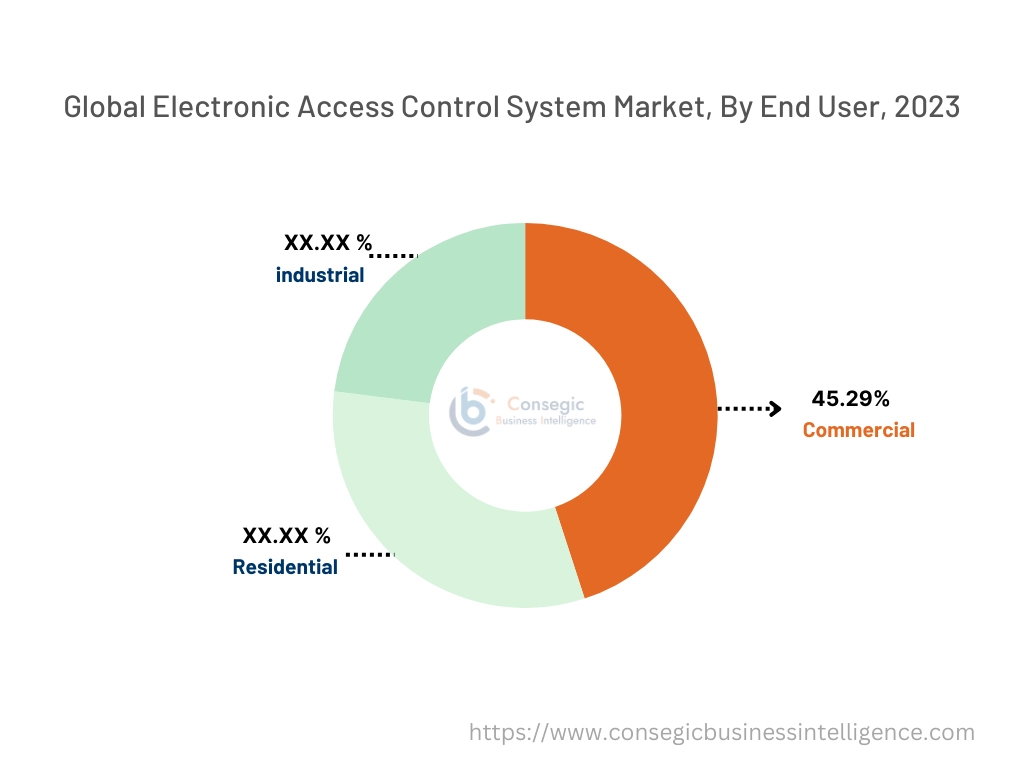
Electronic Access Control System Market Regional Analysis:
The regions covered are North America, Europe, Asia Pacific, the Middle East and Africa, and Latin America.
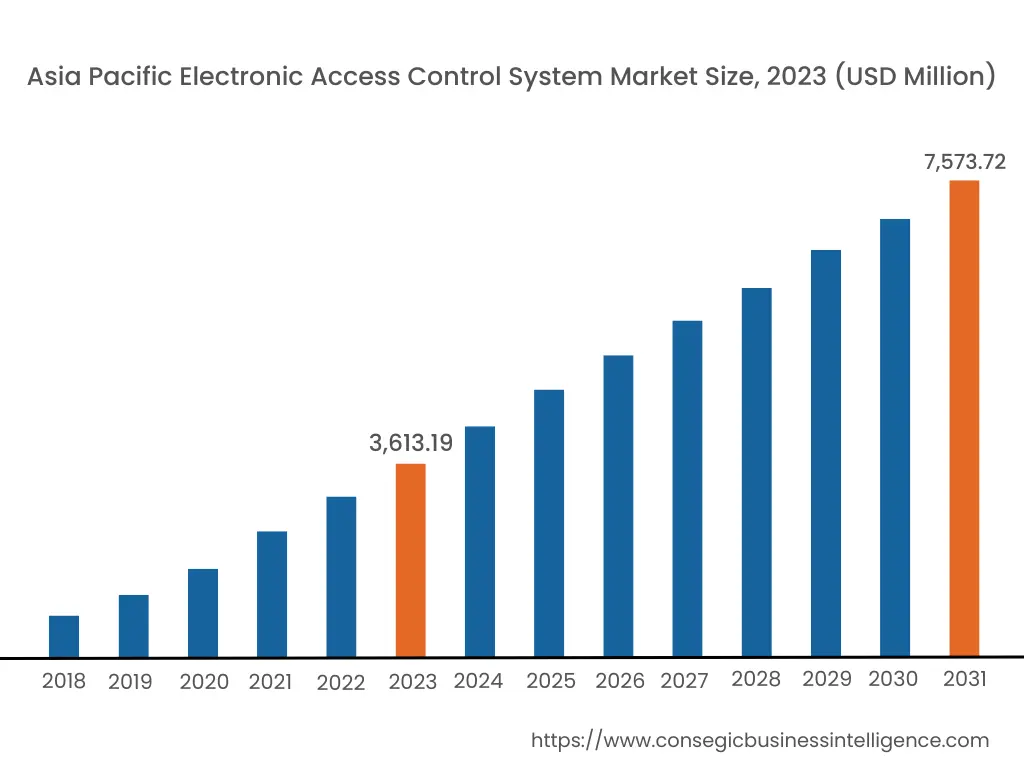
Asia Pacific region was valued at USD 3,613.19 Million in 2023. Moreover, it is projected to grow by USD 3,888.08 Million in 2024 and reach over USD 7,573.72 Million by 2031. Out of this, China accounted for the maximum revenue share of 35.2%.
As per the electronic access control system market analysis, the Asia Pacific region's growing pace of urbanization and development offers lucrative development prospects for the market. Additionally, the growing residential and commercial sectors are contributing to the market growth in the Asia-Pacific region.
- For instance, according to the Building and Construction Authority of Singapore, the total construction demand including residential and commercial construction in Singapore is expected to reach between USD 24 billion to USD 29 billion by the end of 2024. Thus, the above factors are projected to boost the market in the Asia-Pacific region during the forecast period.
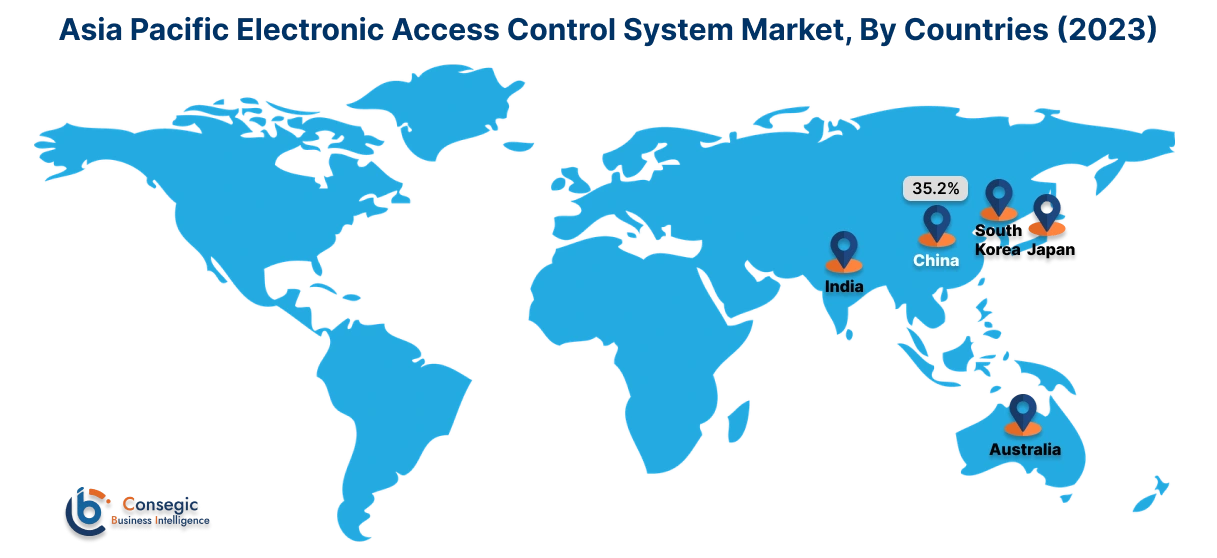
North America is estimated to reach over USD 9,946.83 Million by 2031 from a value of USD 5,042.45 Million in 2023 and is projected to grow by USD 5,397.72 Million in 2024. The market in North America is mainly driven by their increasing deployment in residential and commercial sectors including offices, airports, educational institutes, and financial institutions among others.
- For instance, according to the United States Census Bureau, the total number of new residential units sold in the United States reached up to 666 thousand units in 2023, witnessing a growth of nearly 4% in comparison to 641 thousand units in 2022.
Furthermore, the analysis of regional trends portrays that factors including the increasing incidence of robberies in commercial and residential spaces in the region are projected to drive the electronic access control system market expansion in North America during the forecast period.
As per the electronic access control system market analysis, Europe is anticipated to witness substantial growth that is backed by the increasing adoption of these systems in commercial and industrial buildings. Companies invest in innovative technologies to cater to the surging demand for advanced access control systems across the region.
The Middle East, Africa, and Latin America are expected to grow at a considerable rate due to increasing investments in the development of residential, commercial, and industrial buildings in countries such as Brazil, UAE, and others.
Top Key Players & Market Share Insights:
The electronic access control system industry is highly competitive with major players providing products to the national and international markets. Key players are adopting several strategies in research and development (R&D), product innovation, and end-user launches to hold a strong position in the global electronic access control system market. Key players in the electronic access control system industry include-
- Honeywell International Inc. (U.S)
- Hangzhou Hikvision Digital Technology Co., Ltd. (China)
- Allegion (Ireland)
- Assa Abloy (Sweden)
- Johnson Controls Inc. (U.S)
- ADT (U.S)
- Inovonics Wireless Corporation (U.S)
- Bosch Sicherheitssysteme GmbH (Germany)
- Schneider Electric (France)
- Godrej Group (India)
Recent Industry Developments :
Product Launches:
- In September 2022, Hikvision launched its new iris recognition-based biometric access control system. The biometric system is designed to ensure secure access control to highly sensitive areas such as vaults, banks, hospitals, and others.
Partnerships & Collaborations:
- In April 2024, Schneider Electric partnered with IPConfigure, for integrating the company's Orchid video management system into Schneider Electric's EcoStruxure Building platform. IPConfigure's Orchid will be integrated with Schneider Electric's Security Expert, which combines physical access control and intrusion detection, along with Access Expert, which provides cloud security with video monitoring, visitor management, alarms, and building operations.
Electronic Access Control System Market Report Insights :
| Report Attributes | Report Details |
| Study Timeline | 2018-2031 |
| Market Size in 2031 | USD 28,940.45 Million |
| CAGR (2024-2031) | 8.8% |
| By System Type |
|
| By End User |
|
| By Region |
|
| Key Players |
|
| North America | U.S. Canada Mexico |
| Europe | U.K. Germany France Spain Italy Russia Benelux Rest of Europe |
| APAC | China South Korea Japan India Australia ASEAN Rest of Asia-Pacific |
| Middle East and Africa | GCC Turkey South Africa Rest of MEA |
| LATAM | Brazil Argentina Chile Rest of LATAM |
| Report Coverage |
|
Key Questions Answered in the Report
How big is the electronic access control system market? +
Electronic Access Control System Market size is estimated to reach over USD 28,940.45 Million by 2031 from a value of USD 14,785.44 Million in 2023 and is projected to grow by USD 15,816.87 Million in 2024, growing at a CAGR of 8.8% from 2024 to 2031.
Which is the fastest-growing region in the electronic access control system market? +
Asia-Pacific is the region experiencing the most rapid growth in the electronic access control system market.
What specific segmentation details are covered in the electronic access control system report? +
The electronic access control system report includes specific segmentation details for system type, end user, and region.
Who are the major players in the electronic access control system market? +
The key participants in the electronic access control system market are Honeywell International Inc. (U.S), Hangzhou Hikvision Digital Technology Co., Ltd. (China), ADT (U.S), Allegion (Ireland), Assa Abloy (Sweden), Johnson Controls Inc. (U.S), Inovonics Wireless Corporation (U.S), Bosch.
